Acetaminophen (injection)
Editor-In-Chief: C. Michael Gibson, M.S., M.D. [1]; Associate Editor(s)-in-Chief: Adeel Jamil, M.D. [2]
Disclaimer
WikiDoc MAKES NO GUARANTEE OF VALIDITY. WikiDoc is not a professional health care provider, nor is it a suitable replacement for a licensed healthcare provider. WikiDoc is intended to be an educational tool, not a tool for any form of healthcare delivery. The educational content on WikiDoc drug pages is based upon the FDA package insert, National Library of Medicine content and practice guidelines / consensus statements. WikiDoc does not promote the administration of any medication or device that is not consistent with its labeling. Please read our full disclaimer here.
Black Box Warning
|
Warning
See full prescribing information for complete Boxed Warning.
|
Overview
Acetaminophen (injection) is an analgesic and antipyretic that is FDA approved for the treatment of fever and pain. There is a Black Box Warning for this drug as shown here. Common adverse reactions include pruritus, constipation, nausea, vomiting, headache, agitation, insomnia, and atelectasis.
Adult Indications and Dosage
FDA-Labeled Indications and Dosage (Adult)
Indications
- Acetaminophen injection is indicated for:
- The management of mild to moderate pain
- The management of moderate to severe pain with adjunctive opioid analgesics
- The reduction of fever
General Dosing Information
- Acetaminophen infusion may be given as a single or repeated dose for the treatment of acute pain or fever. No dose adjustment is required when converting between oral acetaminophen and acetaminophen infusion dosing in adults and adolescents who weigh 50 kg and above. Calculated maximum daily dose of acetaminophen is based on all routes of administration (i.e., intravenous, oral, and rectal) and all products containing acetaminophen. Exceeding the maximum mg/kg daily dose of acetaminophen as described in TABLES 1 and 2 may result in hepatic injury, including the risk of liver failure and death. To avoid the risk of overdose, ensure that the total amount of acetaminophen from all routes and from all sources does not exceed the maximum recommended dose.
Recommended Dosage: Adults and Adolescents
- Adults and adolescents weighing 50 kg and over: the recommended dosage acetaminophen infusion is 1000 mg every 6 hours or 650 mg every 4 hours, with a maximum single dose of acetaminophen infusion of 1000 mg, a minimum dosing interval of 4 hours, and a maximum daily dose of acetaminophen of 4000 mg per day (includes all routes of administration and all acetaminophen-containing products including combination products).
- Adults and adolescents weighing under 50 kg: the recommended dosage of acetaminophen infusion is 15 mg/kg every 6 hours or 12.5 mg/kg every 4 hours, with a maximum single dose of acetaminophen infusion of 15 mg/kg, a minimum dosing interval of 4 hours, and a maximum daily dose of acetaminophen of 75 mg/kg per day (includes all routes of administration and all acetaminophen-containing products including combination products).
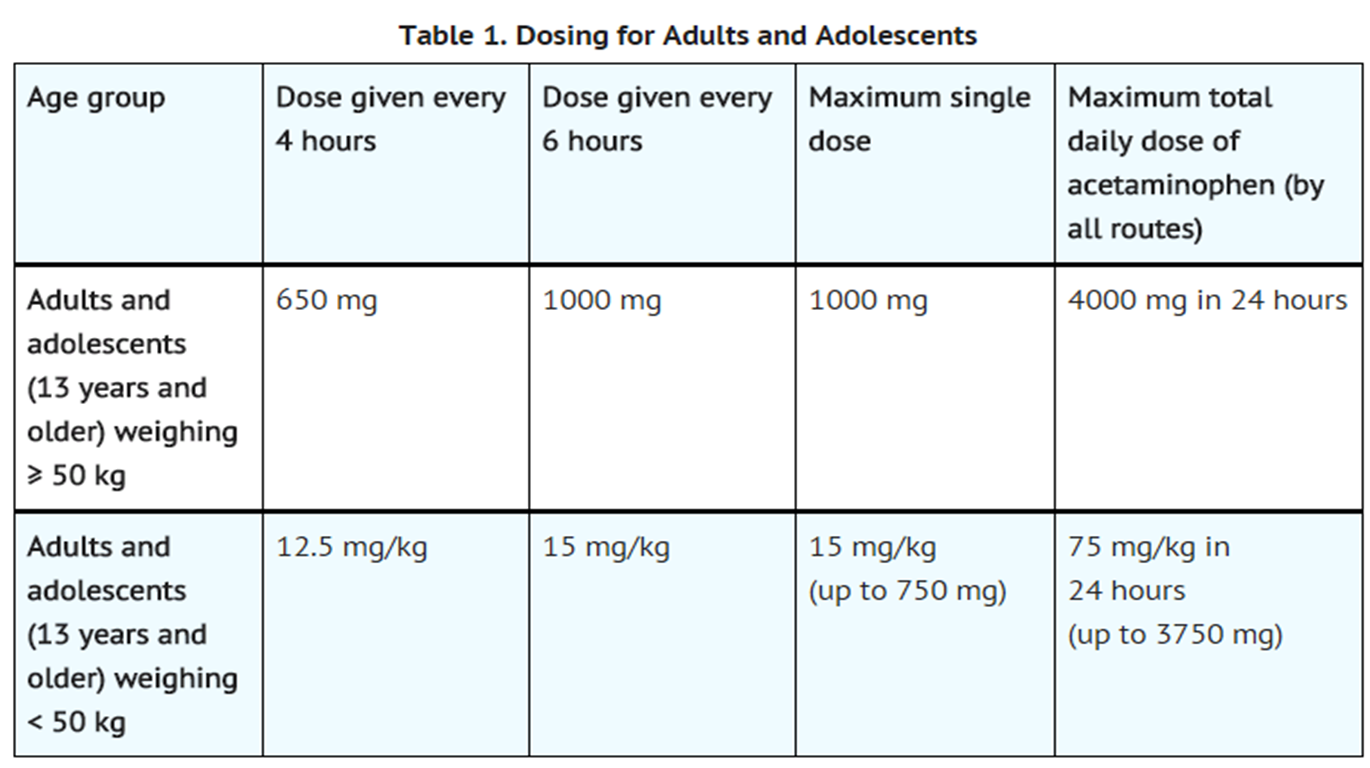
Instructions for Intravenous Administration
- For adult and adolescent patients weighing ≥ 50 kg requiring 1000 mg doses of acetaminophen infusion, administer the dose by inserting a vented intravenous set through the septum of the 100 mL vial. acetaminophen infusion may be administered without further dilution. Examine the vial contents before dose preparation or administering. DO NOT USE if particulate matter or discoloration is observed. Administer the contents of the vial intravenously over 15-minutes. Use aseptic technique when preparing acetaminophen infusion for intravenous infusion. Do not add other medications to the acetaminophen infusion vial or infusion device.
- For doses less than 1000 mg, the appropriate dose must be withdrawn from the vial and placed into a separate container prior to administration. Using aseptic technique, withdraw the appropriate dose (650 mg or weight-based) from an intact sealed acetaminophen infusion vial and place the measured dose in a separate empty, sterile container (e.g. glass bottle, plastic intravenous container, or syringe) for intravenous infusion to avoid the inadvertent delivery and administration of the total volume of the commercially available container. The entire 100 mL vial of acetaminophen infusion is not intended for use in patients weighing less than 50 kg. acetaminophen infusion is a single-use vial and the unused portion must be discarded.
- Place small volume pediatric doses up to 60 mL in volume in a syringe and administer over 15 minutes using a syringe pump.
- Monitor the end of the infusion in order to prevent the possibility of an air embolism, especially in cases where the acetaminophen infusion is the primary infusion.
- Once the vacuum seal of the glass vial has been penetrated, or the contents transferred to another container, administer the dose of acetaminophen infusion within 6 hours.
- Do not add other medications to the acetaminophen infusion solution. Diazepam and chlorpromazine hydrochloride are physically incompatible with acetaminophen infusion, therefore do not administer simultaneously.
Off-Label Use and Dosage (Adult)
Guideline-Supported Use
There is limited information regarding Off-Label Guideline-Supported Use of Acetaminophen (injection) in adult patients.
Non–Guideline-Supported Use
Pediatric Indications and Dosage
FDA-Labeled Indications and Dosage (Pediatric)
Recommended Dosage: Children
- Children 2 to 12 years of age: the recommended dosage of acetaminophen infusion is 15 mg/kg every 6 hours or 12.5 mg/kg every 4 hours, with a maximum single dose of acetaminophen infusion of 15 mg/kg, a minimum dosing interval of 4 hours, and a maximum daily dose of acetaminophen of 75 mg/kg per day.
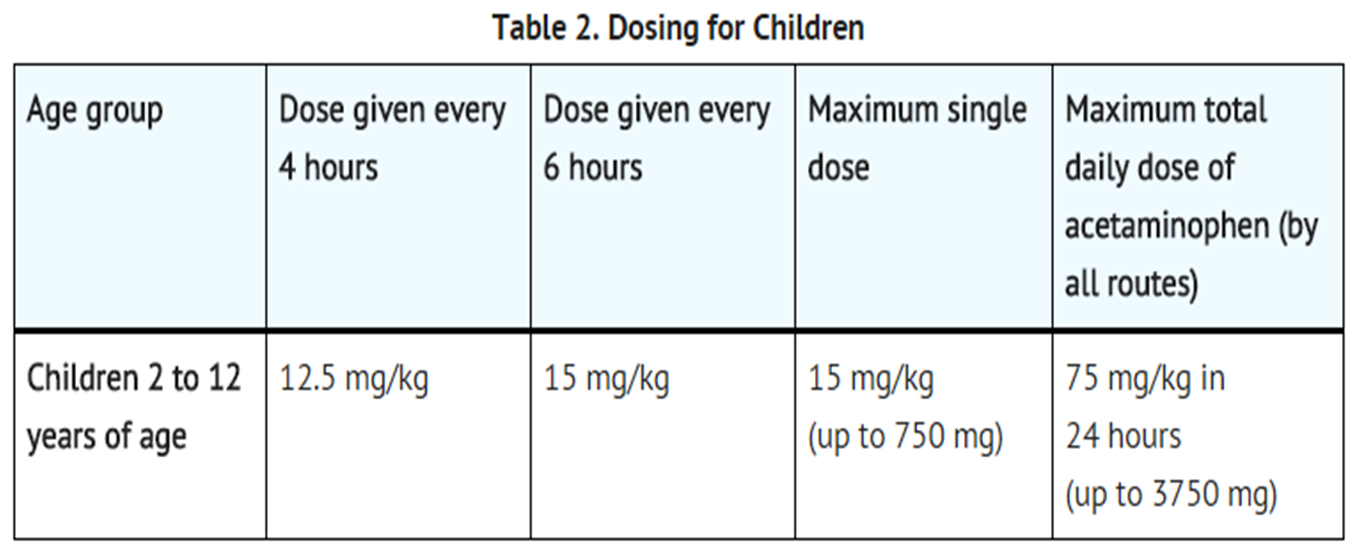
Off-Label Use and Dosage (Pediatric)
Guideline-Supported Use
There is limited information regarding FDA-Labeled Use of acetaminophen infusion in pediatric patients.
Non–Guideline-Supported Use
- Prophylaxis of vaccine adverse reactions
Contraindications
- Acetaminophen is contraindicated:
- In patients with known hypersensitivity to acetaminophen or to any of the excipients in the intravenous formulation.
- In patients with severe hepatic impairment or severe active liver disease.
Warnings
|
Warning
See full prescribing information for complete Boxed Warning.
|
Hepatic Injury
- Administration of acetaminophen in doses higher than recommended may result in hepatic injury, including the risk of liver failure and death. Do not exceed the maximum recommended daily dose of acetaminophen. The maximum recommended daily dose of acetaminophen includes all routes of acetaminophen administration and all acetaminophen-containing products administered, including combination products.
- Use caution when administering acetaminophen in patients with the following conditions: hepatic impairment or active hepatic disease, alcoholism, chronic malnutrition, severe hypovolemia (e.g., due to dehydration or blood loss), or severe renal impairment (creatinine clearance ≤ 30 mL/min).
Serious Skin Reactions
- Rarely, acetaminophen may cause serious skin reactions such as acute generalized exanthematous pustulosis (AGEP), Stevens-Johnson Syndrome (SJS), and toxic epidermal necrolysis (TEN), which can be fatal. Patients should be informed about the signs of serious skin reactions, and use of the drug should be discontinued at the first appearance of skin rash or any other sign of hypersensitivity.
Risk of Medication Errors
- Take care when prescribing, preparing, and administering acetaminophen Injection in order to avoid dosing errors which could result in accidental overdose and death. In particular, be careful to ensure that:
- The dose in milligrams (mg) and milliliters (mL) is not confused;
- The dosing is based on weight for patients under 50 kg;
- infusion pumps are properly programmed; and
- The total daily dose of acetaminophen from all sources does not exceed maximum daily limits.
Allergy and Hypersensitivity
- There have been post-marketing reports of hypersensitivity and anaphylaxis associated with the use of acetaminophen. Clinical signs included swelling of the face, mouth, and throat, respiratory distress, urticaria, rash, and pruritus. There were infrequent reports of life-threatening anaphylaxis requiring emergent medical attention. Discontinue acetaminopen immediately if symptoms associated with allergy or hypersensitivity occur. Do not use in patients with acetaminophen allergy.
Adverse Reactions
Clinical Trials Experience
- The following serious adverse reactions are discussed elsewhere in the labeling:
- Hepatic injury
- Serious skin reactions
- Allergy and hypersensitivity
Clinical Trial Experience
- Because clinical trials are conducted under widely varying conditions, adverse reaction rates observed cannot be directly compared to rates in other clinical trials and may not reflect the rates observed in practice.
Adult Population
- A total of 1020 adult patients have received acetaminophen in clinical trials, including 37.3% (n=380) who received 5 or more doses, and 17.0% (n=173) who received more than 10 doses. Most patients were treated with acetaminophen infusion 1000 mg every 6 hours. A total of 13.1% (n=134) received acetaminophen infusion 650 mg every 4 hours.
- All adverse reactions that occurred in adult patients treated with either acetaminophen infusion or placebo in repeated dose, placebo-controlled clinical trials at an incidence ≥ 3% and at a greater frequency than placebo are listed in TABLE 3. The most common adverse events in adult patients treated with acetaminophen infusion (incidence ≥ 5% and greater than placebo) were nausea, vomiting, headache, and insomnia.
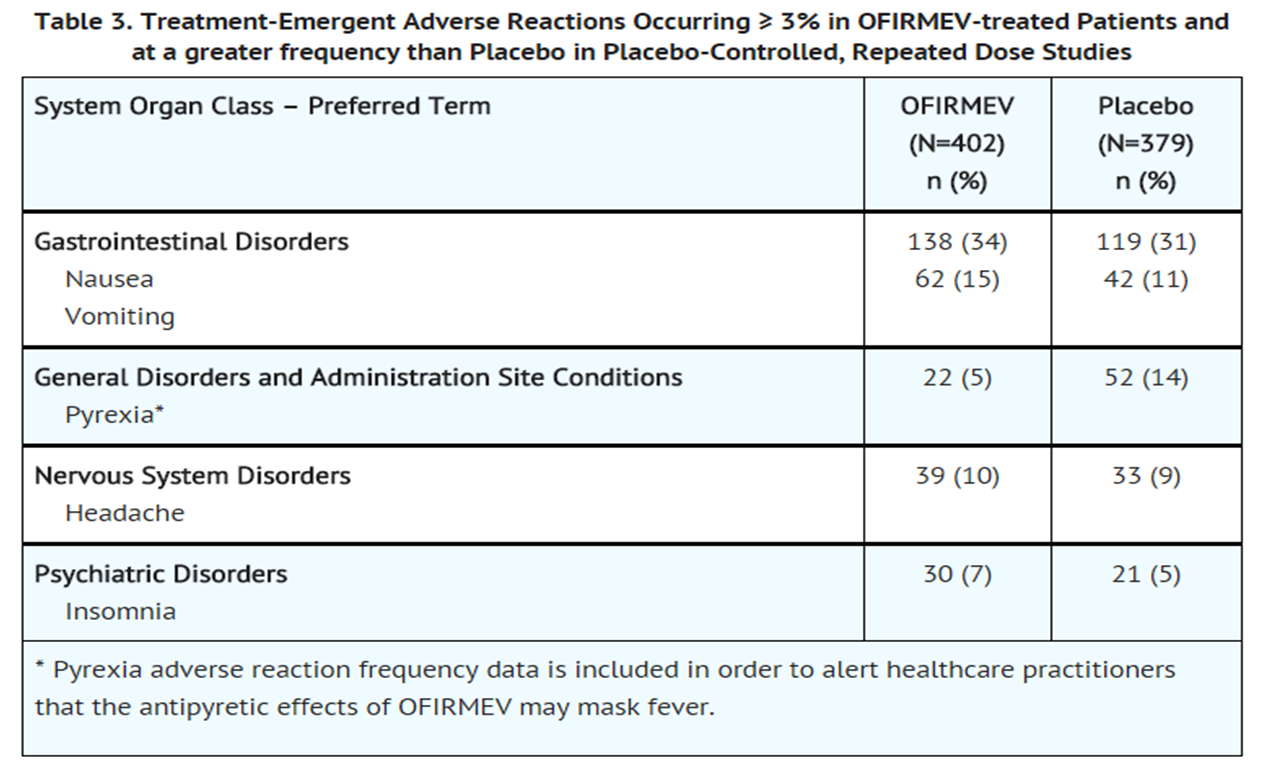
- Other Adverse Reactions Observed During Clinical Studies of acetaminophen infusion in Adults
- The following additional treatment-emergent adverse reactions were reported by adult subjects treated with acetaminophen infusion in all clinical trials (n=1020) that occurred with an incidence of at least 1% and at a frequency greater than placebo (n=525).
- Blood and lymphatic system disorders:
- Investigations:
- Aspartate aminotransferase increased, breath sounds abnormal
- Metabolism and nutrition disorders:
- Psychiatric disorders:
- Respiratory, thoracic and mediastinal disorders:
- Vascular disorders:
Pediatric population
- A total of 355 pediatric patients (47 neonates, 64 infants, 171 children, and 73 adolescents) have received acetaminophen infusion in active-controlled (n=250) and open-label clinical trials (n=225), including 59.7% (n=212) who received 5 or more doses and 43.1% (n=153) who received more than 10 doses. Pediatric patients received acetaminophen infusion doses up to 15 mg/kg on an every 4 hours, every 6 hours, or every 8 hours schedule. The maximum exposure was 7.7, 6.4, 6.8, and 7.1 days in neonates, infants, children, and adolescents, respectively.
- The most common adverse events (incidence ≥ 5%) in pediatric patients treated with acetaminophen infusion were nausea, vomiting, constipation, pruritus, agitation, and atelectasis.
- Other Adverse Reactions Observed During Clinical Studies of acetaminophen infusion in Pediatrics
- The following additional treatment-emergent adverse reactions were reported by pediatric subjects treated with acetaminophen infusion (n=355) that occurred with an incidence of at least 1%.
- Blood and lymphatic system disorders:
- Cardiac disorders:
- Gastrointestinal disorders:
- General disorders and administration site conditions:
- Investigations:
- Hepatic enzyme increase
- Metabolism and nutrition disorders:
- Musculoskeletal and connective tissue disorders:
- Nervous system disorders:
- Psychiatric disorders:
- Renal and urinary disorders:
- Respiratory, thoracic and mediastinal disorders:
- Skin and subcutaneous tissue Disorder (medicine)
Postmarketing Experience
There is limited information regarding Postmarketing Experience about acetaminophen infusion.
Drug Interactions
Effects of other Substances on Acetaminophen=
- Substances that induce or regulate hepatic cytochrome enzyme CYP2E1 may alter the metabolism of acetaminophen and increase its hepatotoxic potential. The clinical consequences of these effects have not been established. Effects of ethanol are complex, because excessive alcohol usage can induce hepatic cytochromes, but ethanol also acts as a competitive inhibitor of the metabolism of acetaminophen.
Anticoagulants
- Chronic oral acetaminophen use at a dose of 4000 mg/day has been shown to cause an increase in international normalized ratio (INR) in some patients who have been stabilized on sodium warfarin as an anticoagulant. As no studies have been performed evaluating the short-term use of acetaminophen infusion in patients on oral anticoagulants, more frequent assessment of INR may be appropriate in such circumstances.
Use in Specific Populations
Pregnancy
- There are no studies of intravenous acetaminophen in pregnant women; however, epidemiological data on oral acetaminophen use in pregnant women show no increased risk of major congenital malformations. Animal reproduction studies have not been conducted with IV acetaminophen, and it is not known whether acetaminophen can cause fetal harm when administered to a pregnant woman. Acetaminophen infusion should be given to a pregnant woman only if clearly needed.
- The results from a large population-based prospective cohort, including data from 26,424 women with live born singletons who were exposed to oral acetaminophen during the first trimester, indicate no increased risk for congenital malformations, compared to a control group of unexposed children. The rate of congenital malformations (4.3%) was similar to the rate in the general population. A population-based, case-control study from the National Birth Defects Prevention Study showed that 11,610 children with prenatal exposure to acetaminophen during the first trimester had no increased risk of major birth defects compared to 4,500 children in the control group. Other epidemiological data showed similar results.
- While animal reproduction studies have not been conducted with intravenous acetaminophen, studies in pregnant rats that received oral acetaminophen during organogenesis at doses up to 0.85 times the maximum human daily dose (MHDD = 4 grams/day, based on a body surface area comparison) showed evidence of fetotoxicity (reduced fetal weight and length) and a dose-related increase in bone variations (reduced ossification and rudimentary rib changes). Offspring had no evidence of external, visceral, or skeletal malformations. When pregnant rats received oral acetaminophen throughout gestation at doses of 1.2-times the MHDD (based on a body surface area comparison), areas of necrosis occurred in both the liver and kidney of pregnant rats and fetuses. These effects did not occur in animals that received oral acetaminophen at doses 0.3-times the MHDD, based on a body surface area comparison.
- In a continuous breeding study, pregnant mice received 0.25, 0.5, or 1.0% acetaminophen via the diet (357, 715, or 1430 mg/kg/day). These doses are approximately 0.43, 0.87, and 1.7 times the MHDD, respectively, based on a body surface area comparison. A dose-related reduction in body weights of fourth and fifth litter offspring of the treated mating pair occurred during lactation and post-weaning at all doses. Animals in the high dose group had a reduced number of litters per mating pair, male offspring with an increased percentage of abnormal sperm, and reduced birth weights in the next generation pups.
Pregnancy Category (AUS):
There is no Australian Drug Evaluation Committee (ADEC) guidance on usage of acetaminophen infusion in women who are pregnant.
Labor and Delivery
- There are no adequate and well-controlled studies with acetaminophen infusion during labor and delivery; therefore, it should be used in such settings only after a careful benefit-risk assessment.
Nursing Mothers
- While studies with acetaminophen infusion have not been conducted, acetaminophen is secreted in human milk in small quantities after oral administration. Based on data from more than 15 nursing mothers, the calculated infant daily dose of acetaminophen is approximately 1 – 2% of the maternal dose. There is one well-documented report of a rash in a breast-fed infant that resolved when the mother stopped acetaminophen use and recurred when she resumed acetaminophen use. Caution should be exercised when acetaminophen infusion is administered to a nursing woman.
Pediatric Use
- The safety and effectiveness of acetaminophen infusion for the treatment of acute pain and fever in pediatric patients ages 2 years and older is supported by evidence from adequate and well-controlled studies of acetaminophen infusion in adults. Additional safety and pharmacokinetic data were collected in 355 patients across the full pediatric age strata, from premature neonates (≥ 32 weeks post menstrual age) to adolescents. The effectiveness of acetaminophen infusion for the treatment of acute pain and fever has not been studied in pediatric patients < 2 years of age.
Geriatic Use
- Of the total number of subjects in clinical studies of acetaminophen infusion, 15% were age 65 and over, while 5% were age 75 and over. No overall differences in safety or effectiveness were observed between these subjects and younger subjects, and other reported clinical experience has not identified differences in responses between the elderly and younger patients, but greater sensitivity of some older individuals cannot be ruled out.
Gender
There is no FDA guidance on the use of acetaminophen infusion with respect to specific gender populations.
Race
There is no FDA guidance on the use of acetaminophen infusion with respect to specific racial populations.
Renal Impairment
- In cases of severe renal impairment (creatinine clearance ≤ 30 mL/min), longer dosing intervals and a reduced total daily dose of acetaminophen may be warranted.
Hepatic Impairment
- Acetaminophen is contraindicated in patients with severe hepatic impairment or severe active liver disease and should be used with caution in patients with hepatic impairment or active liver disease. A reduced total daily dose of acetaminophen may be warranted.
Females of Reproductive Potential and Males
There is no FDA guidance on the use of acetaminophen infusion in women of reproductive potentials and males.
Immunocompromised Patients
There is no FDA guidance one the use of acetaminophen infusion in patients who are immunocompromised.
Others
(Description)
Administration and Monitoring
Administration
Monitoring
There is limited information regarding Monitoring of acetaminophen infusion in the drug label.
IV Compatibility
There is limited information regarding IV Compatibility of acetaminophen infusion in the drug label.
Overdosage
Signs and Symptoms
- In acute acetaminophen overdosage, dose-dependent, potentially fatal hepatic necrosis is the most serious adverse effect. Renal tubular necrosis, hypoglycemic coma, and thrombocytopenia may also occur. Plasma acetaminophen levels > 300 mcg/mL at 4 hours after oral ingestion were associated with hepatic damage in 90% of patients; minimal hepatic damage is anticipated if plasma levels at 4 hours are < 150 mcg/mL or < 37.5 mcg/mL at 12 hours after ingestion. Early symptoms following a potentially hepatotoxic overdose may include: nausea, vomiting, diaphoresis, and general malaise. Clinical and laboratory evidence of hepatic toxicity may not be apparent until 48 to 72 hours post-ingestion.
- Treatment:
- If an acetaminophen overdose is suspected, obtain a serum acetaminophen assay as soon as possible, but no sooner than 4 hours following oral ingestion. Obtain liver function studies initially and repeat at 24-hour intervals. Administer the antidote N-acetylcysteine (NAC) as early as possible. As a guide to treatment of acute ingestion, the acetaminophen level can be plotted against time since oral ingestion on a nomogram (Rumack-Matthew). The lower toxic line on the nomogram is equivalent to 150 mcg/mL at 4 hours and 37.5 mcg/mL at 12 hours. If serum level is above the lower line, administer the entire course of NAC treatment. Withhold NAC therapy if the acetaminophen level is below the lower line.
Pharmacology
Mechanism of Action
- The precise mechanism of the analgesic and antipyretic properties of acetaminophen is not established but is thought to primarily involve central actions.
Structure
Acetaminophen is a non-salicylate antipyretic and non-opioid analgesic agent. Its chemical name is N-acetyl-p-aminophenol. Acetaminophen has a molecular weight of 151.16. Its structural formula is:
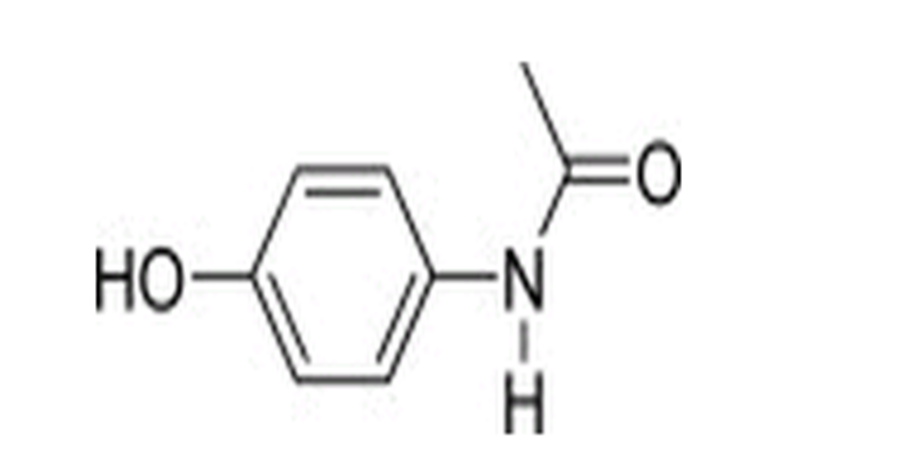
Pharmacodynamics
- Acetaminophen has been shown to have analgesic and antipyretic activities in animal and human studies.
- Single doses of acetaminophen infusion up to 3000 mg and repeated doses of 1000 mg every 6 hours for 48 hours have not been shown to cause a significant effect on platelet aggregation. Acetaminophen does not have any immediate or delayed effects on small-vessel hemostasis. Clinical studies of both healthy subjects and patients with hemophilia showed no significant changes in bleeding time after receiving multiple doses of oral acetaminophen.
Pharmacokinetics
Distribution
- The pharmacokinetics of acetaminophen infusion have been studied in patients and healthy subjects from premature neonates up to adults 60 years old. The pharmacokinetic profile of acetaminophen infusion has been demonstrated to be dose proportional in adults following administration of single doses of 500, 650, and 1000 mg.
- The maximum concentration (Cmax) occurs at the end of the 15 minute intravenous infusion of acetaminophen infusion. Compared to the same dose of oral acetaminophen, the Cmax following administration of acetaminophen infusion is up to 70% higher, while overall exposure (area under the concentration time curve [AUC]) is very similar.
- Pharmacokinetic parameters of acetaminophen infusion(AUC, Cmax, terminal elimination half-life [T½], systemic clearance [CL], and volume of distribution at steady state [Vss]) following administration of a single intravenous dose of 15 mg/kg for the pediatric population and 1000 mg in adults are summarized in TABLE 4.
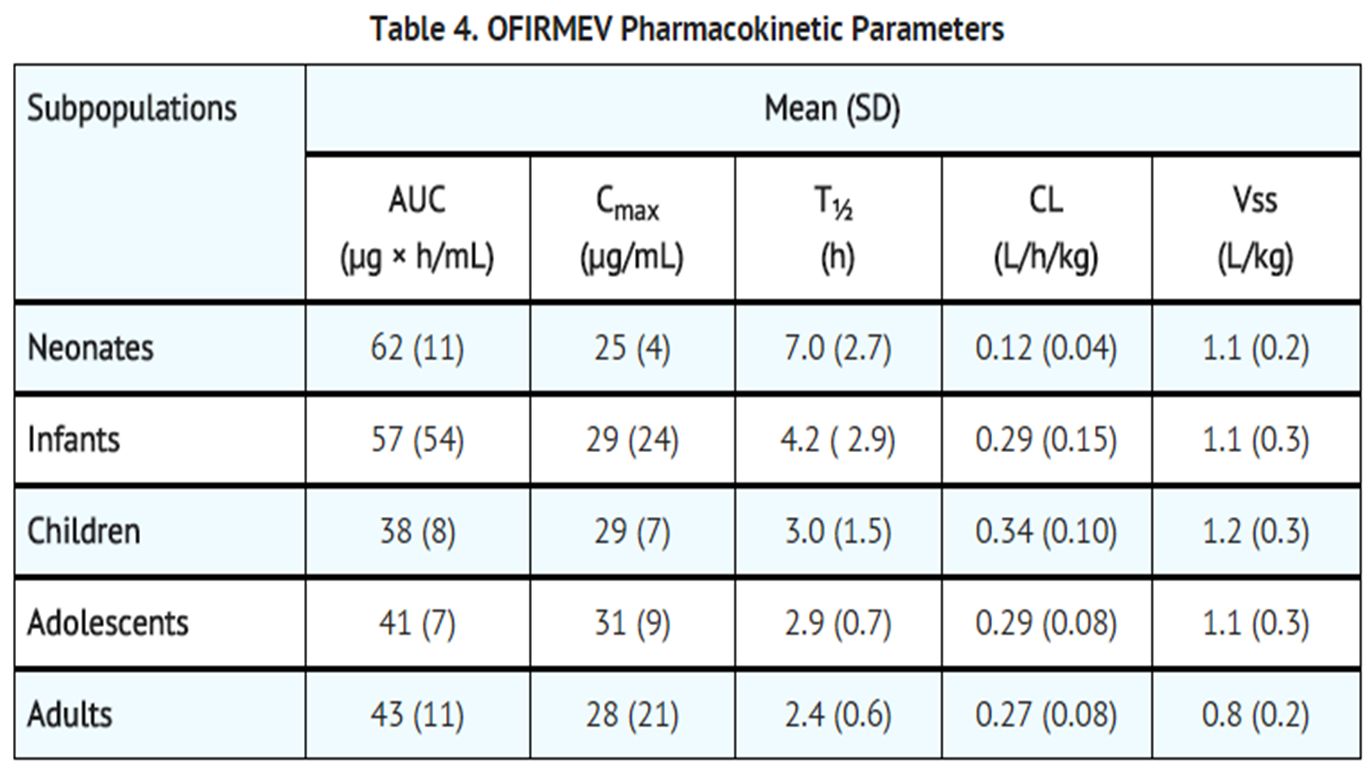
The pharmacokinetic exposure of acetaminophen infusion observed in children and adolescents is similar to adults, but higher in neonates and infants. Dosing simulations from pharmacokinetic data in infants and neonates suggest that dose reductions of 33% in infants 1 month to < 2 years of age, and 50% in neonates up to 28 days, with a minimum dosing interval of 6 hours, will produce a pharmacokinetic exposure similar to that observed in children age 2 years and older.
At therapeutic levels, binding of acetaminophen to plasma proteins is low (ranging from 10% to 25%). Acetaminophen appears to be widely distributed throughout most body tissues except fat.
Metabolism and Excretion
- Acetaminophen is primarily metabolized in the liver by first-order kinetics and involves three principal separate pathways: Conjugation with glucuronide, conjugation with sulfate, and oxidation via the cytochrome P450 enzyme pathway, primarily CYP2E1, to form a reactive intermediate metabolite (N-acetyl-p-benzoquinone imine or NAPQI). With therapeutic doses, NAPQI undergoes rapid conjugation with glutathione and is then further metabolized to form cysteine and mercapturic acid conjugates.
- Acetaminophen metabolites are mainly excreted in the urine. Less than 5% is excreted in the urine as unconjugated (free) acetaminophen and more than 90% of the administered dose is excreted within 24 hours.
Nonclinical Toxicology
Carcinogenesis, Mutagenesis, Impairment of Fertility=
- Carcinogenesis
- Long-term studies in mice and rats have been completed by the National Toxicology Program to evaluate the carcinogenic potential of acetaminophen. In 2-year feeding studies, F344/N rats and B6C3F1 mice were fed a diet containing acetaminophen up to 6000 ppm. Female rats demonstrated equivocal evidence of carcinogenic activity based on increased incidences of mononuclear cell leukemia at 0.8 times the maximum human daily dose (MHDD) of 4 grams/day, based on a body surface area comparison. In contrast, there was no evidence of carcinogenic activity in male rats (0.7 times) or mice (1.2-1.4 times the MHDD, based on a body surface area comparison).
- Mutagenesis
- Acetaminophen was not mutagenic in the bacterial reverse mutation assay (Ames test). In contrast, acetaminophen tested positive in the in vitro mouse lymphoma assay and the in vitro chromosomal aberration assay using human lymphocytes. In the published literature, acetaminophen has been reported to be clastogenic when administered a dose of 1500 mg/kg/day to the rat model (3.6-times the MHDD, based on a body surface area comparison). In contrast, no clastogenicity was noted at a dose of 750 mg/kg/day (1.8-times the MHDD, based on a body surface area comparison), suggesting a threshold effect.
- Impairment of fertility
- In studies conducted by the National Toxicology Program, fertility assessments have been completed in Swiss mice via a continuous breeding study. There were no effects on fertility parameters in mice consuming up to 1.7 times the MHDD of acetaminophen, based on a body surface area comparison. Although there was no effect on sperm motility or sperm density in the epididymis, there was a significant increase in the percentage of abnormal sperm in mice consuming 1.7 times the MHDD (based on a body surface area comparison) and there was a reduction in the number of mating pairs producing a fifth litter at this dose, suggesting the potential for cumulative toxicity with chronic administration of acetaminophen near the upper limit of daily dosing.
- Published studies in rodents report that oral acetaminophen treatment of male animals at doses that are 1.2 times the MHDD and greater (based on a body surface area comparison) result in decreased testicular weights, reduced spermatogenesis, reduced fertility, and reduced implantation sites in females given the same doses. These effects appear to increase with the duration of treatment. The clinical significance of these findings is not known.
Clinical Studies
Adult Acute Pain
- The efficacy of acetaminophen infusion in the treatment of acute pain in adults was evaluated in two randomized, double-blind, placebo controlled clinical trials in patients with postoperative pain.
- Pain Study 1 evaluated the analgesic efficacy of repeated doses of acetaminophen infusion l000 mg vs. placebo every 6 hours for 24 hours in 101 patients with moderate to severe pain following total hip replacement or knee replacement. acetaminophen infusion was statistically superior to placebo for reduction in pain intensity over 24 hours. There was an attendant decrease in opioid consumption, the clinical benefit of which was not demonstrated.
- Pain Study 2 evaluated the analgesic efficacy of repeated doses of acetaminophen infusion 1000 mg every 6 hours or 650 mg every 4 hours for 24 hours versus placebo in the treatment of 244 patients with moderate to severe postoperative pain after abdominal laparoscopic surgery. Patients receiving acetaminophen infusion experienced a statistically significant greater reduction in pain intensity over 24 hours compared to placebo.
Adult Fever
- The efficacy of acetaminophen infusion 1000 mg in the treatment of adult fever was evaluated in one randomized, double-blind, placebo-controlled clinical trial. The study was a 6-hour, single-dose, endotoxin-induced fever study in 60 healthy adult males. A statistically significant antipyretic effect of acetaminophen infusion was demonstrated through 6 hours in comparison to placebo. The mean temperature over time is shown in FIGURE 1.
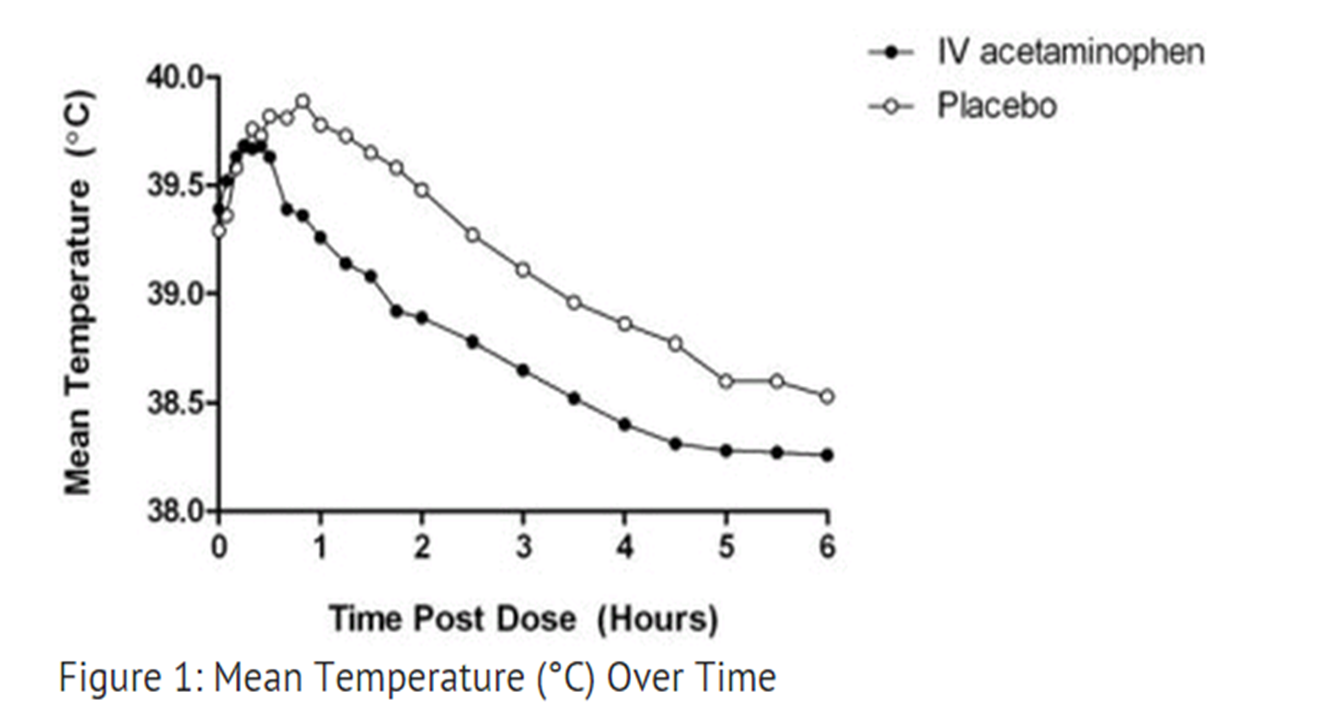
Pediatric Acute Pain and Fever
- Acetaminophen infusion was studied in 355 pediatric patients in two active-controlled and three open-label safety and pharmacokinetic trials.
How Supplied
- Acetaminophen infusion is supplied in a 100 mL glass vial containing 1000 mg acetaminophen (10 mg/mL).
- Carton of 24 vials, NDC 43825-102-01
- For single use only. The product should be used within 6 hours after opening. Do not refrigerate or freeze.
- OFIRMEV injection
- Manufactured for:
- Cadence Pharmaceuticals, Inc.
- San Diego, CA 92130
- Revised: 10/2013
- © 2013 Cadence Pharmaceuticals, Inc. All rights reserved.
- OFIRMEV® and CADENCE® are registered trademarks of Cadence Pharmaceuticals, Inc.
- U.S. PATENT NUMBERS: 6,028,222; 6,992,218 Label part number
Storage
- Acetaminophen infusion should be stored at 20 °C to 25 °C (68 °F to 77 °F).
Images
Drug Images
{{#ask: Page Name::Acetaminophen (injection) |?Pill Name |?Drug Name |?Pill Ingred |?Pill Imprint |?Pill Dosage |?Pill Color |?Pill Shape |?Pill Size (mm) |?Pill Scoring |?NDC |?Drug Author |format=template |template=DrugPageImages |mainlabel=- |sort=Pill Name }}
Package and Label Display Panel
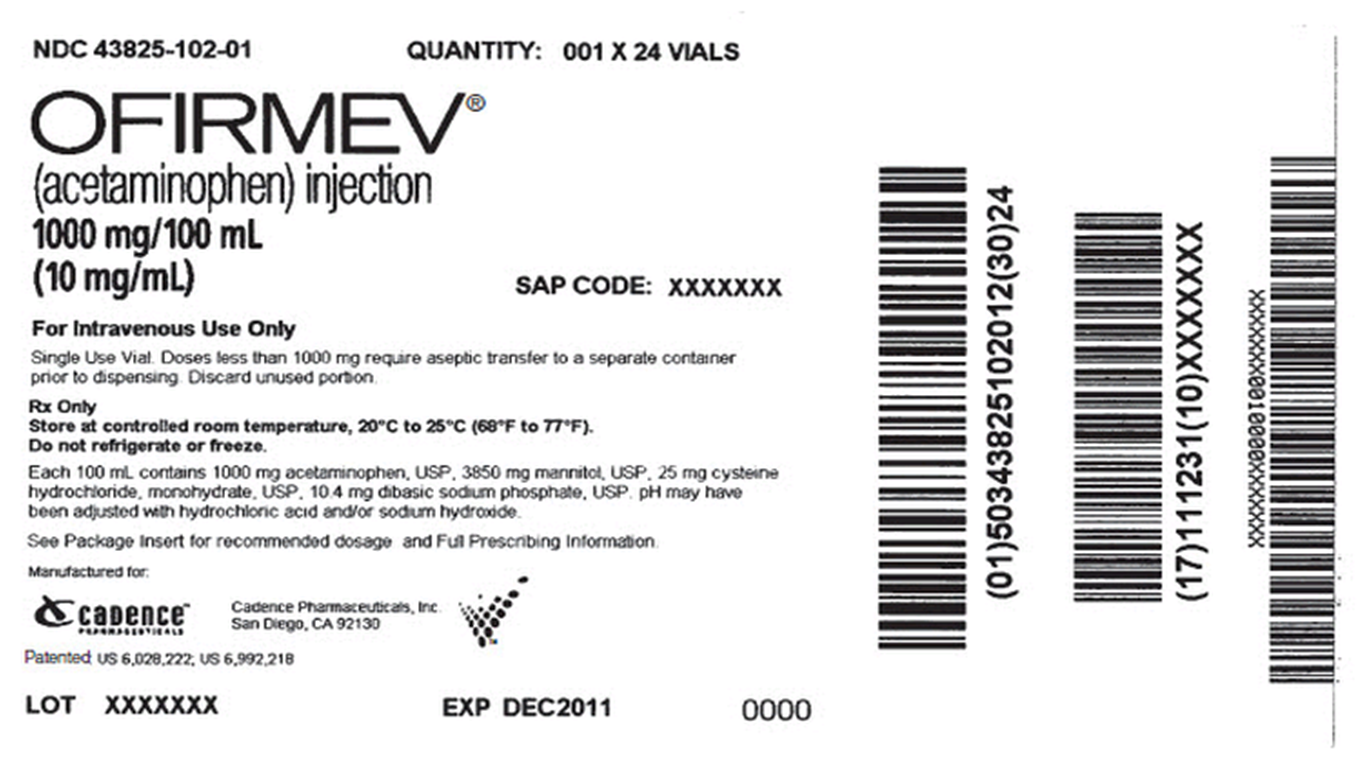
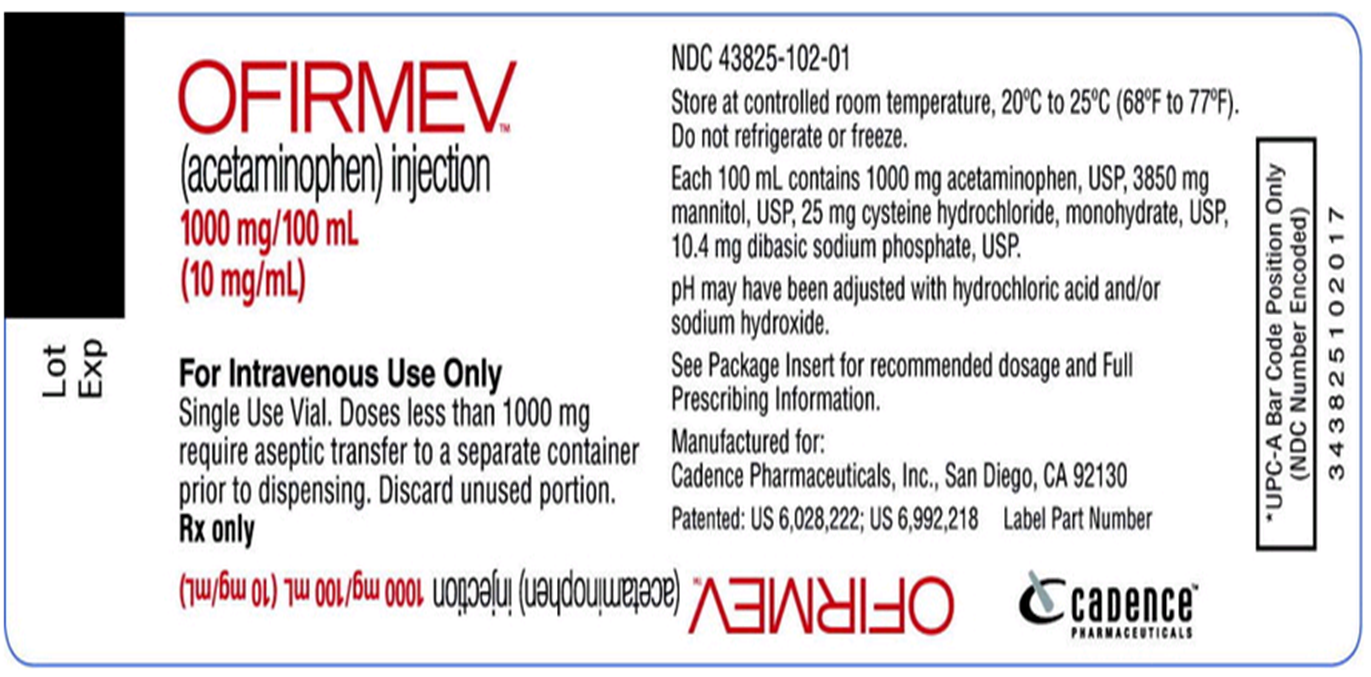
{{#ask: Label Page::Acetaminophen (injection) |?Label Name |format=template |template=DrugLabelImages |mainlabel=- |sort=Label Page }}
Patient Counseling Information
There is limited information regarding Patient Counseling Information of acetaminophen infusion in the drug label.
Precautions with Alcohol
- Use caution when administering acetaminophen in patients with alcoholism.
- Substances that induce or regulate hepatic cytochrome enzyme CYP2E1 may alter the metabolism of acetaminophen and increase its hepatotoxic potential. The clinical consequences of these effects have not been established. Effects of ethanol are complex, because excessive alcohol usage can induce hepatic cytochromes, but ethanol also acts as a competitive inhibitor of the metabolism of acetaminophen.
Brand Names
- OFIRMEV®[7]
- Tylenol®
- Genapap®
- Feverall®
- Actamin Maximum Strength®
- Altenol®
- Aminofen®
- Ofirmev®
- Anacin Aspirin Free®
Look-Alike Drug Names
- Tylenol® – Tylenol PM®
Drug Shortage Status
Drug Shortage
Price
References
The contents of this FDA label are provided by the National Library of Medicine.
- ↑ Template:Cite doi
- ↑ "melting point data for paracetamol". Lxsrv7.oru.edu. Retrieved 2011-03-19.
- ↑ Granberg RA, Rasmuson AC (1999). "Solubility of paracetamol in pure solvents". Journal of Chemical & Engineering Data. 44 (6): 1391–95. doi:10.1021/je990124v.
- ↑ Template:Cite isbn
- ↑ "Tylenol, Tylenol [[infants]]' Drops (acetaminophen) dosing, indications, interactions, adverse effects, and more". Medscape Reference. WebMD. Retrieved 10 May 2014. URL–wikilink conflict (help)
- ↑ 6.0 6.1 6.2 "Codapane Forte Paracetamol and codeine phosphate PRODUCT INFORMATION" (PDF). TGA eBusiness Services. Alphapharm Pty Limited. 29 April 2013. Retrieved 10 May 2014.
- ↑ "OFIRMEV- acetaminophen injection, solution".
